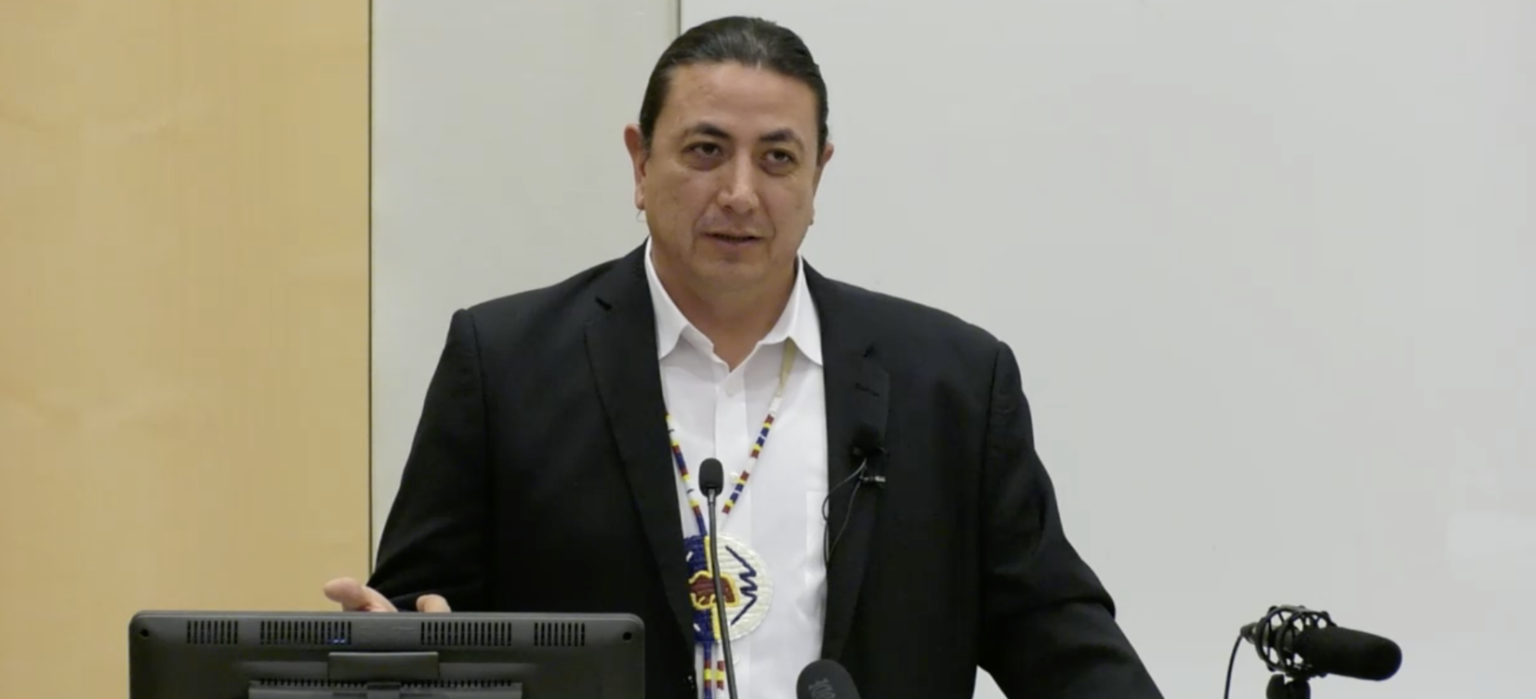“It’s time to do something and no longer sit back.” That was the message that David Archambault II, chairman of the Standing Rock Sioux Nation, delivered to an audience at Cornell University on February 16. His comments came just a week before the February 22 deadline set by the U.S. Army Corps of Engineers and echoed by North Dakota governor Doug Burgum for those at the Standing Rock encampments to evacuate.
While the overflow crowd was certainly drawn there because of the Standing Rock protests against the Dakota Access pipeline, the title of Archambault’s seminar was “Standing Rock: The Violation of Indigenous Peoples’ Rights.” While he did discuss the months-long protests, the talk covered a wide range of topics, adding essential historical context to the tribe’s modern struggle against the pipeline.
History Repeating Itself at Standing Rock
Archambault spent the first half of his talk, which is well worth viewing, sharing the history of the Standing Rock Sioux. He described how, prior to the pipeline protests, he would introduce the Standing Rock Sioux to people by saying, “Do you know who Sitting Bull is? That’s my tribe.”
While the Battle of Little Bighorn, also known as Custer’s Last Stand, is well known to most Americans, what probably isn’t as well known is that this battle involved the Standing Rock Sioux and was a fight over land and natural resources. The Black Hills of North Dakota were Sioux territory, as outlined in the Treaty of Fort Laramie, but that treaty was signed before people knew there was gold in the Black Hills. After General George A. Custer guided an excursion of miners into the area which made this discovery, he and the U.S. military confronted the Sioux, purportedly in the name of protecting the miners who had moved into the Black Hills. And while Custer wasn’t successful, the government eventually took control of the land in 1877.
The Sioux are still fighting to regain the land which the Supreme Court ruled in 1980 was taken illegally.
Archambault gave a sobering and detailed history of the Sioux’s relationship with the United States government. Among the many topics covered was the Pick-Sloan Act of 1944, a U.S. plan for flood control and navigation, which he described as “the largest dam system in the world.” And that dam system would end up flooding the most valuable lands of the Standing Rock Sioux and forcing many to — once again — relocate.
As the website Native American Netroots reports, water rights and land use have long been contentious issues between the U.S. Army Corps of Engineers and Standing Rock Sioux:
“In 1948 the Army Corps of Engineers began construction of Oahe Dam in South Dakota. The Oahe Dam would destroy more Indian land than any other public works project in America. The project destroyed 90 percent of the timber land on the Standing Rock Sioux and Cheyenne River Sioux reservations as well as the most valuable rangeland, most of the gardens and cultivated areas, and the wild fruit and wildlife resources.”
Archambault explained how the most valuable land in the Dakotas was the land along rivers and that is where the Standing Rock Sioux had settled but with the Pick-Sloan Act and the dams built as a result of it, he explained that “by 1958 we had our most precious lands flooded.”
The current fight over the Dakota Access pipeline crossing the Missouri River at Lake Oahe is just one more in a long line of events in which U.S. entities break treaties with the Sioux to allow for non-indigneous people and private corporations to profit from the natural resources in the Dakotas.
“What I’m sharing with you are the wrongs that have been committed to us. And there’s been a lot of wrongs,” Archambault said. “And it’s important that you understand that so that you understand what happened at Standing Rock and this movement.”
Standing Rock and the Environment
Just as the discovery of gold in the Black Hills had severe impacts for the Sioux, the discovery of “black gold” in North Dakota has also affected the Sioux.
“In 2007 our tribe said we don’t want pipelines in our ancestral lands because we saw not only the bad that was coming with the social ills with this oil boom but we saw the environmental ills,” Archambault said. “We saw unregulated pipelines being punched in, we saw fracking solutions, fracking water.”
“In 2012 we had a tribal member going around Standing Rock trying to lease land. And he was going around telling people he wants to frack,” Arambault recounted. “So the Standing Rock Sioux tribe said we don’t want that. We know what happens to the environment when you do that. So we said we don’t want this. Not only we don’t want the fracking, we don’t want the pipelines. We took action way before the Dakota Access pipeline.”
Archambault also recounted how in 2013 the Standing Rock Sioux opposed the Keystone XL pipeline. And then in 2014 Energy Transfer Partners met with the tribal council to discuss the Dakota Access pipeline. According to Archambault, the message delivered that day to the pipeline company was: “Don’t do it, you are going to meet resistance.”
The audio from that 2014 meeting is available on Youtube and if you listen to the words of former councilwoman Phyllis Young, it would be hard to say that the message wasn’t clear.
“Do not underestimate the people of Standing Rock. We know what is going on and we know what belongs to us,” Young said. Later in the recording Young says, “We will do whatever we have to do to stop this pipeline,” emphasizing that “I will never submit to any pipeline to go through my homeland.”
The Movement Is Bigger Than Standing Rock
“One of the things that I want to do is make sure we do create that hope,” Archambault said in his opening remarks. “The hope that is necessary for the future.”
And despite spending the next hour acknowledging the significant challenges facing the Standing Rock Sioux and the country as a whole, Archambault remained optimistic:
“This movement is something that started in Standing Rock and it is about water but it’s also about what each and every one of us can do. Because we know that Mother Earth is in trouble. All we have to do is look at the facts … what’s going on. The temperature of this earth is heating up. The ice caps are melting. Glaciers are disappearing. The ocean levels are rising. Currents are changing. Coral reefs are disappearing. These are facts. So there is something happening. And so we have to make a difference.”
Archambault admitted that he never expected the movement at Standing Rock to reach the level that it has.
“This movement has been something special. It’s been something that I never anticipated … I never thought it was going to be something this great, this special, this beautiful.”
And while Archambault didn’t foresee the strength of the Standing Rock movement, he believes it should be used to address bigger issues.
“There is momentum there. And we can keep that momentum going regardless of what happens,” he said.
Subscribe to our newsletter
Stay up to date with DeSmog news and alerts







